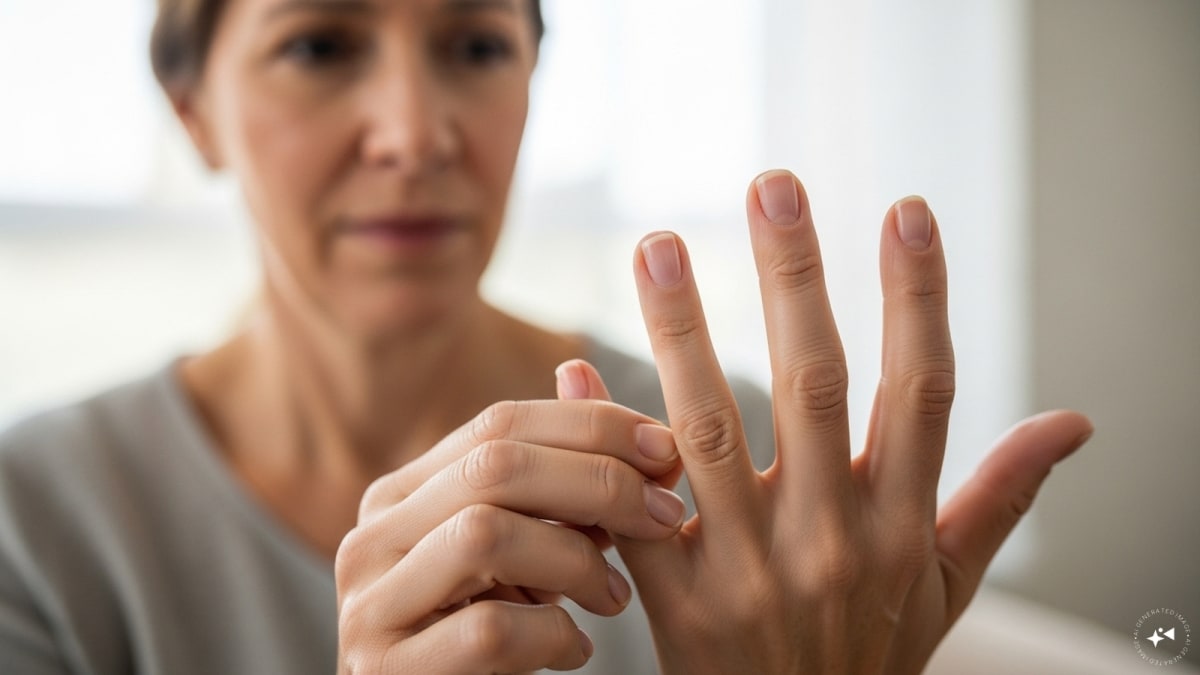Last Updated:
Your body often gives subtle clues about internal changes long before it become serious. Finger clubbing is a small but potentially vital indicator of lung cancer

Approximately 1% of lung cancer patients show clinical signs of clubbing, a lesser-known early symptom which is often overlooked (Image: Representational)
Lung cancer remains the leading cause of cancer-related deaths worldwide. According to the World Health Organization (WHO), it accounts for nearly 1.8 million deaths annually, surpassing colon, breast, and prostate cancers combined. While smoking continues to be the primary cause, rising exposure to air pollution, both indoor and outdoor, has intensified global concern.
In India, lung cancer contributes to 5.9% of all cancer cases and 8.1% of all cancer-related deaths. The National Cancer Registry Programme had projected an alarming increase in cases from 61,219 in 2015 to over 81,000 by 2025. What makes this particularly worrying is that most lung cancers are detected only after they have advanced, limiting treatment options.
While persistent coughing, weight loss, and shortness of breath are familiar symptoms, there is a lesser-known but fascinating early sign that many overlook, a subtle change in the shape of your fingernails, known as finger clubbing.
What Does Lung Cancer Have to Do with Your Fingers?
The idea that a problem in the lungs could show up in the fingers sounds strange, but doctors have long noted this link. Finger clubbing, sometimes called digital clubbing, refers to a swelling and rounding of the fingertips that causes nails to curve downward like an upside-down spoon.
Researchers believe this change occurs due to chronic low oxygen levels in the blood, a common issue in people with lung disease. The body reacts by producing growth factors that stimulate the formation of new blood vessels under the nail bed, leading to swelling and softening of the fingertips.
According to Cancer Research UK, around 1% of people with lung cancer develop clubbed nails. While that number is small, the symptom can appear before other warning signs, making it worth recognising.
What Is Finger Clubbing?
Finger clubbing is a gradual process. It typically starts with the nail bed becoming soft and spongy. Over time, the nail begins to curve, and the fingertip looks bulbous or rounded. The nails may feel warm, appear red, and sometimes even cause mild discomfort. Doctors classify clubbing into three stages:
- Fluctuation and softening of the nail bed
- Increased convexity of the nail
- Thickening of the fingertips
It usually develops slowly, making it easy to miss in the early stages. The condition itself is not dangerous and often reverses once the underlying illness—such as lung cancer is treated. However, if left unchecked, clubbing can indicate long-standing disease or chronic inflammation.
Why Does Lung Cancer Cause Finger Clubbing?
The exact mechanism is not fully understood, but researchers have developed strong theories. One of the most accepted explanations involves a protein called vascular endothelial growth factor (VEGF).
When lung tissue is deprived of oxygen, the body releases VEGF to promote new blood vessel growth. These vessels increase blood flow to the fingertips, leading to fluid buildup and swelling. Over time, the nails change shape as the tissues beneath expand.
Simply put, your body is trying to adapt to a lack of oxygen, and your fingertips end up showing the results. A Respiratory Medicine study from 2022 found that approximately 1% of lung cancer patients show clinical signs of clubbing. While rare, it is a reliable physical clue that can alert physicians to an underlying lung or heart disorder.
Is Finger Clubbing Always Linked to Cancer?
No, and that is a crucial point. Finger clubbing can occur in several other conditions, many unrelated to cancer. Some of the more common causes include:
- Heart diseases such as congenital heart defects or infective endocarditis
- Chronic lung diseases like bronchiectasis, cystic fibrosis, or chronic infections
- Liver cirrhosis, which causes scarring of the liver tissue
- Gastrointestinal conditions such as Crohn’s disease and ulcerative colitis
It can also occur in people with thyroid or autoimmune disorders, including Graves’ disease. In other words, finger clubbing is not a diagnosis in itself—it is a signal that the body is reacting to an internal imbalance.
How Can You Check If You Have Finger Clubbing?
Doctors often use a simple visual test called the Schamroth Window Test. Place the tips of your two index fingers together, nail to nail, forming a small diamond-shaped window between them. If you can see a clear diamond gap, your nails are normal. If there is no gap and the fingers touch completely flat against each other, this could be a sign of clubbing.
While it is a quick and non-invasive way to assess nail changes, it should not replace medical evaluation. If you notice this change, consult your GP, who may order a chest X-ray or a CT scan to check for lung abnormalities.
What Other Early Symptoms Should You Watch For?
Lung cancer can be elusive in its early stages. Many symptoms overlap with common respiratory issues, which delays diagnosis. The NHS lists several warning signs that warrant medical attention:
- A persistent cough lasting more than three weeks
- Coughing up blood or rust-coloured phlegm
- Shortness of breath or wheezing
- Chest pain that worsens with breathing, coughing, or laughing
- Unexplained weight loss
- Hoarseness or a raspy voice
- Recurring chest infections that do not respond to treatment
A study in The Lancet Oncology highlighted that catching lung cancer early can improve survival rates by up to 56 percent in localised cases, compared to less than 7 percent when detected late. Recognising subtle signs such as finger clubbing can therefore have real, life-saving implications.
Who Is Most at Risk of Developing Lung Cancer?
Lung cancer risk is influenced by a combination of genetic, environmental, and lifestyle factors. The most significant contributor remains smoking, which accounts for nearly 85 percent of all cases globally. However, non-smokers are not immune. Key risk factors include:
- Exposure to secondhand smoke
- Radon gas, a naturally occurring radioactive gas that seeps through soil into buildings
- Air pollution, particularly fine particulate matter (PM2.5), linked to up to 20 percent of lung cancer deaths in non-smokers, according to WHO data
- Occupational hazards, including asbestos, arsenic, and diesel fumes
- Family history of lung or other respiratory cancers
It is estimated that air pollution alone causes 300,000 lung cancer deaths annually, highlighting the growing environmental impact on respiratory health.
When Should You See a Doctor?
If you notice clubbing or any persistent respiratory symptoms, it is essential to seek medical evaluation promptly. Doctors typically begin with imaging tests such as a chest X-ray or low-dose CT scan to check for abnormal growths or lesions.
Early detection can significantly improve outcomes. The UK’s NHS Lung Health Check programme has shown promising results, identifying early-stage cancers in high-risk groups, often before symptoms appear.
Dr Neil Faller, a consultant pulmonologist, notes, “Clubbing can sometimes appear months before a diagnosis. That is why it is vital for people at risk especially smokers or those with occupational exposure to undergo regular screening.”
Can Finger Clubbing Reverse After Treatment?
In many cases it is reversible. When the underlying cause whether it is lung cancer, heart disease, or another chronic condition is treated successfully, the nails can gradually return to their normal shape. However, in some individuals, structural changes remain permanent even after recovery.
Physical therapy, nutritional support, and oxygen therapy may help reduce symptoms in chronic cases. Regular monitoring ensures that any recurrence is caught early.
October 23, 2025, 17:48 IST
Stay Ahead, Read Faster
Scan the QR code to download the News18 app and enjoy a seamless news experience anytime, anywhere.






